|
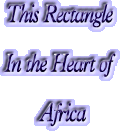



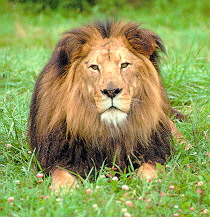

"The
Lions" Are Africa's Kings

They've
just lifted the African Cup of
Nations...
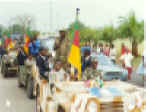
Most
of the people who plan to visit
Africa would like to tour many places
at the same time. For example, they
would like to go to a place where
they can see most of the wild animals
they have often heard about, admire
the beauty of the desert, go into
the deep forest to discover some
rare species of plants, hunt wild
animals, enjoy a tropical beach
and attend some colorful folk festivals.
Not many people know that Cameroon
is the best place to go if someone
wants all these things at the same
place. This is a brief presentation
of the country to people who don't
know much about it.

Located
on the West African coast, Cameroon
is bordered by the Gulf of Guinea,
Nigeria, Chad, Central African Republic,
Congo, Gabon and Equatorial Guinea.
The country has some varied geographical
features and offers a blend of cultures
due to the high number of ethnic
groups (about 200, with as many
native languages) that make it unique
in Africa. One can find not only
the tropical wet forest in southern
Cameroon, but also a semi-desert
in the north. The littoral, which
consists of seashores, offers a
wide range of natural beaches with
gold sand, while the West offers
marvelous valleys and mountains,
as well as some folk festivals.
The north offers some beautiful
landscapes and famous national parks.
The Southern part of the country
is a good starting point for a tour
of Cameroon.
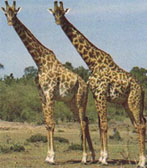
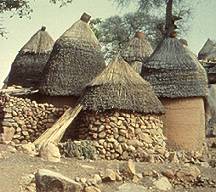
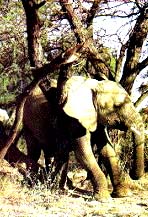
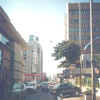

|

|

- Area:
475,442 sq.km Population:
15,435,000 inhabitants
- Density:
27.8 inhabitants/sq.km
-
Per Capita GDP: about US$1600
- Official
Languages: French and English
- Currency:CFA
Franc (about 563CFA=1US$)
Cameroon
is one of Africa's best kept
secrets. The country is known
as Africa in miniature. From
the tropical south to the
sahel in the north, and from
the palm-fringe beaches to
the majestic mountains, Cameroon
is a rich blend of cultures
and landscapes. If you visit
my country, don't miss the
WAZA PARK!
North Cameroon presents unexpected
natural landscapes, with an average
altitude of 1,500 m (4,900 ft) and
plains, reaching an altitude of
300 m (1,000 ft), covered by savanna.
Places to visit are the Mandara
Mountains along the Mayo River,
which are a picturesque and rocky
landscape, and the village of Rhumsiki.
It features a maze of paths linking
the small farms known as the kapsiki;
here live the Kirdi, whose customs
and folklore have changed little
for centuries. The Benoue River,
which rises here and flows westwards
into the Niger in Nigeria, is home
to hippopotamuses, crocodiles and
antelopes. In the Waza National
Park, lions and buffaloes can be
glimpsed as they come to the waterholes
to drink. Elephants, giraffes, antelopes,
hartebeests, cob cheetahs and warthogs
are also numerous. There is also
a rich variety of birds: eagles,
crested cranes, maribons, pelicans,
ducks, geese and numerous guinea
fowls flying in the park sky.

The
Waza National Park
|
|
I
recommend you to make a trip
in the Western Province, and
visit the ancient Kingdom
Palaces...
The west of the country is
very beautiful: volcanic peaks
covered by bamboo forest rise
to over 2,000 m (6,500 ft),
with waterfalls and villages
scattered over the lower slopes.
Here the temperature is pleasantly
cool and each town has a museum
and a craft market. There
are many traditional buildings
dating from the periods of
German, British and French
colonization, or farther in
the past. Here are the Palace
the Sultan of Bamoun, the
palace of the German Governor
and some traditional kingdom
palaces. These ancient kingdoms
have bequeathed a multitude
of monuments reflecting their
historical grandeur. In this
region, colorful folk festivals
and feast days are numerous,
which is interesting for visitors.
On these uplands, the savanna
starts, which continues to
the north.
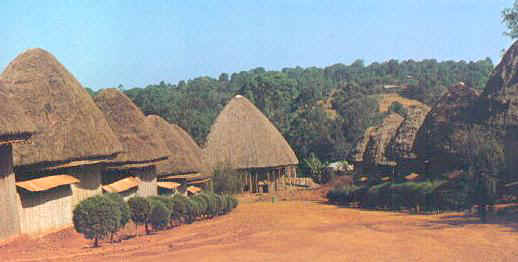
Bamileke's
Early Architecture
|
|
This
is Yaounde, the Capital City

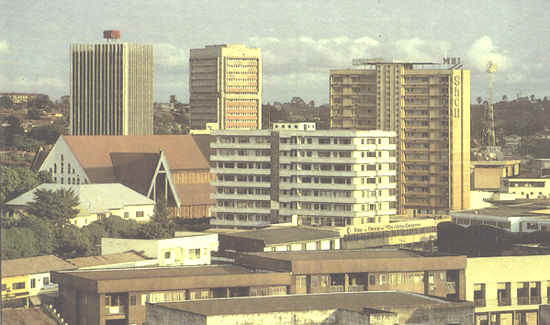
Yaounde,
The Capital City
South
and East Cameroon are mainly
covered by dense equatorial
forest, which make them interesting
places for safaris or for
those who want to observe
wild animals such as lions,
tigers, elephants, monkeys,
antelopes and buffaloes. in
their natural environment.
This region consists of jungle-clad
mountains and spectacular
waterfalls such as Nachtigal
Falls on the river Sanaga,
so named after the German
born explorer who was the
first European impressed by
its beauty. It has an abundant
wild life, most notably a
rich population of gorillas.
In the Campo Reserve Region,
which is a national park,
buffaloes, lions and elephants
roam the deep virgin forest.
Tourists visiting this region
should not forget to tour
pygmy villages. Pygmies are
short people living in the
forest who have not been influenced
by modern civilization. A
tour of these primitive people
can start in Kribi, a small
town located on the seashore,
which is going to be the next
step of our trip.
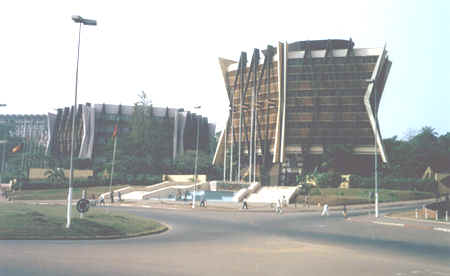
The
Prime Minister's Office
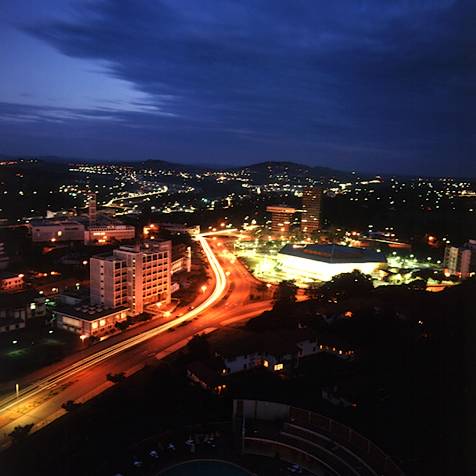
Yaounde
by Night
|
|
This
is Douala,
my Home Town

Douala,
The Port
The
coastal region, situated in
the southwest of Cameroon,
is tropical and cultivated.
Here is a domain of natural
beaches with gold and white
sand. "Londji", located in
Kribi, is perhaps the finest
of all. Places such as museums,
which are mainly craft/souvenir
markets and the Wouri Bridge
located in the city of Douala
are worth visiting. Limbe
is a pleasant small port with
some beautiful white sandy
beaches and a botanical garden
for flower lovers. Here also
is located The Jungle Village,
a national park where rare
botanical species are grown
and protected. For those interested
in climbing, Buea is a charming
town situated on the slopes
of Mount Cameroon. Mount Cameroon,
which is the highest mountain
in West Africa, rises to over
4,000 m (13,200 ft), but is
relatively easy to climb.
The road westward to Dschang
and Foumban passes through
some splendid scenery. There
are a succession of spectacular
valleys and waterfalls consisting
of palm tree, banana, pineapple
and coffee farms. This road
leads the tourist to the west.
|
|









